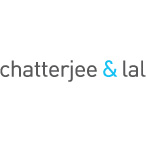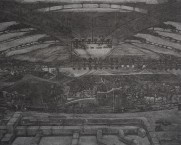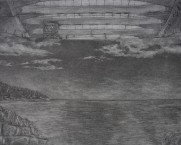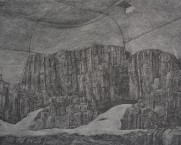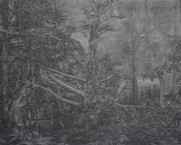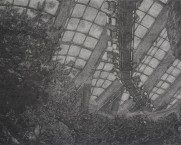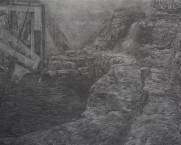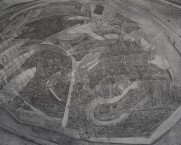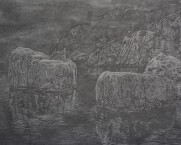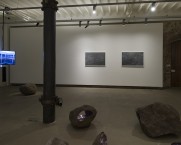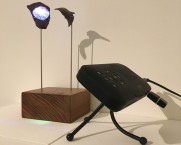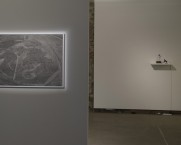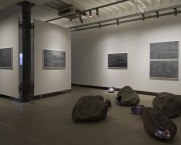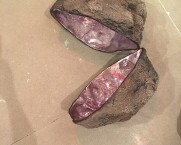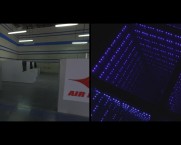C&L Shows
The Tour
Amshu Chukki
2017
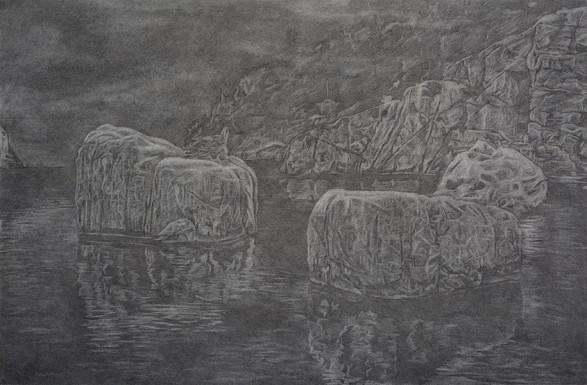
Overview
Namaste and myself Nagarajuna, I’m your tour guide.
A camera trails across a deserted landscape, and we could be in any urban metropolis, emptied of its inhabitants. Our narrator, Nagarajuna, with a voice strong and clear as the sun that pours into the scene, says, “Look, now, a different atmosphere has been created here. You know what is that atmosphere?” Words disappear. Atmosphere remains.
In Amshu Chukki’s, The Tour (2017), a two-channel video installation shot in the Ramoji Film City in Hyderabad, the camera moves like a nervous, first-time player of a first-person shooter game, never quite finding a protagonist upon which to settle. The narrator, a tour guide, is a total fabulist, whose storytelling has been sharpened by years of navigating the Film City landscape. Chukki acts as provocateur: allowing the tour guide to set off on fantastical recitals – where he often speaks to us from the future. A speculation of the future is a constant theme in Chukki’s work, he asks, “How can we use collective ideations to carve out space for futures that are resilient, compelling, and beautiful?”
Chukki’s practice often investigates constructed spaces, such as the Film City, and their innate fiction-making potential. In the exhibition, Chukki deconstructs the nature of a Biodome in Montreal through several iterations: a single-channel video, with the sporadic voice-over of a tour guide; charcoal drawings on paper; and fibreglass sculptures that, with their iridescent corners, extend Chukki’s conjecture onto the sculptural plane. Chukki cites Japanese filmmaker Masao Adachi as an inspiration, in whose film A.K.A Serial Killer, a parodic voice-over (narrated by Adachi himself) explains the departure from linear story telling and asks that we focus on the fragmented, and forensic, nature of the landscape itself. Similarly, in The Tour, Chukki is determined to show us that although the film city is a fluid space, prone to alterations with each new film, it is still hyper-localised – a locality fluently narrated by its most enthusiastic inhabitant: the tour guide.
In the exhibition, we are given the fragments of a landscape: starting with the large and small fiberglass boulders. These are casts of real boulders Chukki found while in Hyderabad, characteristic of the rocky terrain of the Deccan Plateau. From a distance they look real, heavy, and, even, otherworldly. But upon closer look, the illusion dissolves easily, and instead we are pulled into the glimmers of iridescence painted onto their corners, or along their interior. Chukki uses these highlights sparingly, and hopes that we chance upon them while moving around the work. The smaller rock sculptures, if viewed head-on, appear as though flattened and two-dimensional. The addition of chrome paint intensifies the relationship between the sculptures’ pulpy interiors and the light that falls upon them. The light seems to infinitely bounce off the sculptures’ inner grooves, as though caught in its own dramatic interplay.
The drawings in the exhibition are erasures: Chukki fills up a page with dusty, flaky charcoal, before beginning a long process of wiping away, or erasing through its layers. Each drawing is achieved through a process of excavation. The artist pours over the large sheets of paper, with a toolkit of sharpened erasers, slowly carving out their forms. The drawings enact a language of liquidity: everything looks as though it may suddenly shift, or dissolve into the haze from which it emerges. Although Chukki builds enigmatic landscapes full of illusions, the illusions are not always meant to hold, or to always convince. In the accompanying film, The Mountain, Les Invisibles, while the camera is panning across the interiors of the Biodome, suddenly a wall cracks open, letting a staff member through a hidden door. Chukki is interested in the movement of people in the Biodome, staff and visitors alike, and how they are both part of the illusion, as they are privy to break it. The camera travels slowly across the plants that bloom in their entirely artificial atmosphere; in a space like this, what is real? What is fiction? It doesn’t matter.
Chukki builds a landscape in which everything is connected, and where it is difficult to see things in isolation. One work collapses into the other, or a single element repeats in unexpected ways: take for instance the choice of the lavender iridescence that peeks at us from inside the rock sculptures, where upon a closer inspection, the same lustrous tones may be found in the coin-sized film of another work, Remembering the Sea (2014). In this work, Chukki has extracted a seascape from Tarkovsky’s film Solaris (1972), a Soviet science-fiction film based on Stanislaw Lem’s novel of the same title. The extract of the film is projected onto a small piece of carved driftwood, mounted on a metal stand. The film is both magnified and minimised – the sea abstracted to a single loop of itself. The film dissolves into the grain of the wood, and film and material becoming a single unit by their juxtaposition. “When I start a work, I start with a figure. But slowly through my process, that figure is completely obscured,” Chukki explains.
Chukki takes us through chameleon-like spaces that both adapt to, and shed, the fictions to which they are introduced. It is a deconstruction of what it means to make fiction, and also the presentation of a landscape in which to do so ourselves. The cinematic experience is broken spatially, and, as viewers, it is as though we stumble into revelations about what we are shown. “All signals got disrupted,” says Nagarajuna over the scene of an empty airplane cabin, “Rocks fell from the sky, everyone disappeared in a minute. Where did they go?”
~ Skye Arundhati Thomas
